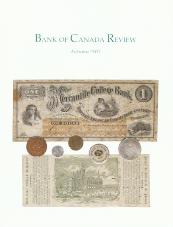Autumn 2002

|
Is Canada Dollarized? by John Murray and James Powell
CLS Bank: Managing Foreign Exchange Settlement Risk
Purchasing-Power Parity: Definition, Measurement, and Interpretation
See also: Tables A1, A2, and Notes to the Tables |
Cover: Business College Currency
Schools with business programs, especially business colleges, of the late 19th and early 20th centuries included the study of financial instruments in general use as part of their curricula. Textbooks devoted whole chapters to currency, promissory notes, and various types of drafts. Many institutions even produced their own "currencies" to teach students money-handling techniques. Taking its name from these institutions, business college currency provides today's viewers with a somewhat lighthearted look at business education a century ago.
The heyday of college currency was the period from about 1865 to the First World War. Produced by local token manufacturers and printing firms for institutions in various countries, these "instruments" superficially resembled genuine currency. Tokens were largely struck in copper, brass, or aluminum in values ranging from 1 cent to 50 cents—the highest denomination struck for use in Canada during this period. Most "note" issues, like their genuine counterparts, bore denominations, decorative vignettes, serial numbers, and authorizing signatures.
The majority of the known issues came from the United States. Canadian issues were largely from central Canada—Ontario and Quebec—although a few were used in the Maritimes and the West.
It may have been designed to resemble authentic money, but business college currency had no value other than as a teaching tool. To make the distinction clear, and to prevent fraudulent use, certain elements of their design clearly identified these instruments as simulations. The name of the college, portraits and signatures of its principals, views of its buildings, and information about the currency's use and the issuing institution in general were included in their design. And nonsensical denominations, like the one featured on the cover for one-tenth of one per cent of one dollar, were often used.
Today, these instruments are nothing but pleasant ephemera of bygone days. Where they once helped to teach students how to handle money, they now illustrate for a modern audience accustomed to credit cards and other forms of electronic payment the importance that "hard cash" had in the 19th century.
The artifacts pictured on the cover form part of the National Currency Collection, Bank of Canada.
Photographed by Gord Carter, Ottawa




